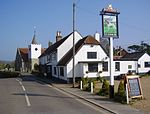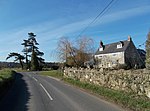All Saints' Church, Newchurch

All Saints' Church, Newchurch is a parish church in the Church of England located in Newchurch, Isle of Wight, England. The church is medieval dating from the 13th century. In 1883, restoration of the church was carried out by A.R. Barker, at the instigation of the vicar Rev. Alfred Dicker.The simple layout of the church consists of a nave, a chancel, northern and southern aisles, and a tower. It was built on the site of an older structure which was donated by William FitzOsbern to the Lyre Abbey. Subsequently, the church came under the control of the Beaulieu Abbey. When this religious authority was dissolved, the control of the church was entrusted by Henry VIII to the Bishop of Bristol (now Gloucester and Bristol).The church was one of the seven parishes on the Island when it was built, but now is part of several others. The unique white timber clad tower contains a small peal of six bells with a tenor weighing just 7 cwt or 350 kg.
Excerpt from the Wikipedia article All Saints' Church, Newchurch (License: CC BY-SA 3.0, Authors, Images).All Saints' Church, Newchurch
High Street,
Geographical coordinates (GPS) Address Nearby Places Show on map
Geographical coordinates (GPS)
| Latitude | Longitude |
|---|---|
| N 50.666666666667 ° | E -1.2061111111111 ° |
Address
High Street
PO36 0NQ
England, United Kingdom
Open on Google Maps







